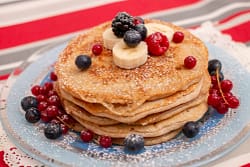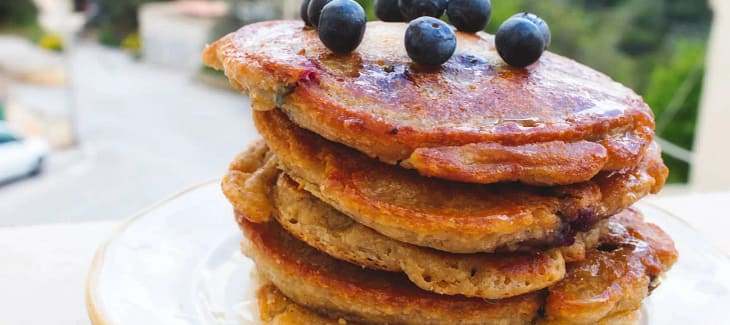When you need to eat healthier carbohydrates in the morning, you can never go wrong with whole wheat pancakes. A classic, archaic recipe, these pancakes are dense in fiber, protein, and minerals. Whole grain and whole wheat foods are picking up in popularity now because of their positive health benefits compared to white flour. Also, pancakes (and waffles) in general are super beginner-friendly, due to their low ingredient requirements. Anyone can gather a few key ingredients such as whole wheat flour, eggs, and buttermilk and get started right away.
When you consume white wheat pancakes or store-bought pancakes, you always risk the chance of bloating or grogginess. In fact, white flour is absurdly cheap to make and doesn’t have nearly as much fiber as whole wheat. If you want to live a healthier lifestyle, become fitter, and stave off calories easier, I recommend trying more whole wheat foods. These homemade whole wheat waffles are a great way to get started!
This recipe can also be used to make whole wheat waffles. All you need is a waffle iron and basic knowledge of how to make the batter. Both pancakes and waffles can be made with the exact same ingredients. They tend to be crispier than pancakes, however.
Whole Wheat Flour Vs. White/Refined Flour
Many experts agree that whole wheat bread is better for your health than white bread. The reasons are quite obvious when you do your research. Both wheat types are carbohydrates, some of the most abundant carbohydrate sources on our planet. However, white wheat’s carb content comes from glucose, while whole wheat’s carb content comes from fiber. Fiber is more important for the health of your body for a few reasons. Before continuing, it is important to note that all wheat varieties should be avoided if you have a gluten allergy, celiac disease, or irritable bowel syndrome.
Glucose is easily digested by the body and provides quick calories in a pinch. This is why white bread is great in survival situations-it is the cheapest food in the world and can be replicated very fast. But long-term consumption of white wheat can be problematic for your health because it doesn’t boast many vitamins, minerals, or antioxidants. It can lead to weight gain because it can increase your insulin sensitivity.
Even scarier, several studies have concluded that white wheat can increase your risk of type-2 diabetes and heart disease. Heart disease is one of the leading causes of death worldwide, and I believe overconsumption of white wheat and unhealthy store-bought foods is a big contributor to this. Sadly, many people in third-world countries like to eat these foods because they’re so cheap and abundant.
Fiber, on the other hand, is an essential carbohydrate that the body needs to help digest food. Fiber helps give bulk to stools and allows the easy passage of foods entering your gut. Whole wheat is also high in magnesium, which works in tandem with fiber to metabolize carbs and improve your nerve-to-muscle connections.
Fiber does a lot more than just help you digest food, however. It stays in your gut throughout the whole day, making you feel satisfied for a long time. Whole wheat is great for weight loss for this very reason-it helps you stave off calories. Athletes trying to stay shredded and healthy often use whole wheat in many breakfast and lunch meals due to this reason. Additionally, fiber is important for regulating blood sugar levels, which white bread is infamously bad at. When your blood sugars are properly balanced, it also means your cardiovascular system can perform its job better. This, in turn, reduces your risk of heart disease and makes you live longer.
Whole Wheat Health Benefits
Here are several health benefits of eating whole wheat foods, which contain plenty of insoluble fiber:
Whole wheat foods are decently high in protein. Protein works together with fiber to make you feel full and strong. This is why whole wheat bread is common in many dietician-approved meal plans. Covering whole wheat bread in avocado, for example, covers all the bases in terms of macronutrient intake. Whole wheat pancakes are great to have in the morning as they will jumpstart your protein consumption for the day.
The protein count of whole wheat is also convenient for vegans and vegetarians. They can combine whole wheat foods with other plant-based foods that are naturally high in protein, such as tofu and legumes.
Whole wheat is high in vitamins and minerals. Whole wheat is high in B vitamins such as niacin, thiamine, and folate. Their mineral content is very plentiful, containing important minerals such as zinc, iron, magnesium, copper, and manganese. Iron is important for arterial health, and magnesium is helpful for maintaining muscle mass.
Whole wheat is the best carbohydrate for weight management. As stated earlier, the fiber content of whole wheat pancakes is high enough to make you feel full and satisfied. As a result, you will be less tempted to grab calorie-adding snacks throughout your day. People who eat whole wheat consistently are almost guaranteed to lose fat when combined with exercise and a high-protein diet. Who doesn’t want a slimmer, more aesthetic body?
Whole grains contain plenty of antioxidants. Antioxidants are natural molecules, found in plant-based foods, that neutralize molecules known as free radicals. Free radicals can cause cell damage in the form of cancers and tumors. The plant compounds found in whole wheat contain important antioxidants like phytic acid, ferulic acid, and lignans.
Whole wheat helps you digest other foods easier. Whole wheat contains insoluble fiber, which is the fiber that helps create stable stools and speeds up digestion. This fiber is important for weight loss, indigestion, and constipation. When eating whole wheat foods, try to drink plenty of water as well so your body can absorb nutrients more easily.

What makes whole wheat pancakes different from regular pancakes?
With whole wheat pancakes, you are going to get more protein and fiber out of them. Your body will also metabolize the whole grains more slowly, allowing you to stay full for longer. In terms of their composition and texture, whole wheat pancakes are going to be denser and slightly more bitter than refined, white-flour pancakes.
It is important that you don’t eat too much whole wheat, as it can make you feel lethargic. So, I would recommend making less pancakes than you normally would. For example, I can usually eat three pancakes at a time, but when making pancakes infused with whole wheat flour, I would only make two. Don’t worry about getting less fiber, because you can always add toppings like fruit and granola to the finished product to add more fiber. Usually, though, there will be no need because the fiber count is already high enough.
Pancakes infused with flour like all-purpose or refined wheat tend to be lighter and fluffier. They may also retain water better, which is great if you have a skillet that burns easily. However, regular pancakes contain almost no protein, vitamins, or minerals. They mainly serve the purpose of a versatile and highly customizable breakfast concoction.
In summary, whole wheat pancakes are thicker, denser, and much more nutritious than white flour pancakes. White flour pancakes, however, taste better without syrup and require less work to be airy and fluffy.
Essential ingredients in whole wheat pancakes
6 ingredients are required in all pancake recipes to ensure your homemade pancakes come out perfectly. These cannot be ignored!
Whole wheat flour
Ground from the whole grain, this is flour in its simplest, most natural form. They can easily be found in most supermarkets worldwide. It is more tan or brown in color than refined flour.
Since whole wheat is denser than all-purpose flour, you’ll have to experiment with the flour and see which batter thickness works right for you.
The amount of whole wheat flour you use relative to every other ingredient is the most important factor in the consistency of your batter. You may need to use 30-50% more flour than liquid to compensate for whole wheat’s greater absorption rate.
Need a gluten-free alternative? Try using gluten-free oat flour or buckwheat flour, as they will still contain the healthy fibers that makes whole wheat so valuable.
Eggs
Eggs play the role of binding fats and liquid together from the milk, which gives structure to your batter. Without eggs, your batter will never be able to cook on a skillet, because it will be too fluid. If you are vegan, try using flax eggs instead-they work just as well.
Primary Liquid (Milk or water)
The thickness of your batter will be in direct proportion to the amount of liquid you put in your batter. For regular pancakes, water is a good choice to put in your batter, but for whole wheat, milk is better. Whole wheat pancakes benefit a lot from milk because the richness of milk counteracts the bitterness of whole wheat. Buttermilk is my favorite milk option because it has the most richness and brings fluff and moistness. Whole milk, cashew milk, and 2% milk are also good milk options.
Use water if you want less fat in your pancakes and you allow the batter to sit for a while before cooking.
Cooking Fat
Unsalted butter, canola oil, and coconut oil tend to be the best fats to cook pancakes with. They prevent your pancakes from burning and give them a flavorful fatty coating. Coconut oil/vegetable oil, mixed into your batter, helps make the pancakes less dry and more moist.
Baking soda + baking powder
These two ingredients are necessary to make your pancakes rise during cooking. This gives them that fluffy and spongy exterior. Without them, your pancakes will not be able to cook well at all.
Salt
Salt affects the texture of pancakes by strengthening gluten. It makes the cooked pancakes have better structure and taste chewier.
Other ingredients
Try these flavor-enhancing ingredients to change up the otherwise bland flavor of whole wheat pancakes.
- Cinnamon spice. This delicious spice adds much-needed flavor in your pancakes, especially if you’re using water.
- Vanilla extract. Great in small doses to give your pancakes a vanilla kick.
- Greek Yogurt. Greek yogurt is high in protein and probiotics. You can add a cup of yogurt to any pancake recipe, which will result in fluffier and more nutrient-dense pancakes. Do not replace the milk or water with it, simply add a cup to any standard pancake recipe.
- Chocolate chips and banana slices. Two toppings that you can easily throw in during cooking, before the pancakes solidify. Other mix-ins like blueberry and strawberry are also fine to use.
- Maple syrup/honey. The most popular pancake topping to add sugary flavor and wetness. Syrup is the final “glue” that binds together all the flavor inside your pancakes, making for a perfect breakfast. Honey is a better option if you want a healthy syrup alternative, which has its own unique taste.
- Half and half cream. This dairy ingredient isn’t necessary, but it may be a viable option to use if you crave more thickness in your batter. It gives the pancake a similar consistency to Greek yogurt.

Basic Whole Wheat Pancakes
Equipment
- 1 whisk
- 1 wooden spoon
- 2 large bowls
- 1 skillet
- 1 spatula for flipping
- measuring cups for proper portioning
Ingredients
- 1 cup whole wheat flour
- 1 cup buttermilk
- 2 large eggs
- 2 tbsp melted coconut oil
- ¼ tsp salt
- 1 tsp baking powder
- 1 tsp baking soda
- ½ tsp cinnamon spice
- 1 tsp vanilla extract
- unsalted butter or coconut oil for lubricating your skillet
Instructions
- Whisk all dry ingredients together in a large bowl. Set it aside.
- In a separate bowl, whisk together all wet ingredients, except the oil. Stir everything until combined, then add the oil in gently. Stir again.
- Create a small hole in the center of your dry bowl, then pour the wet bowl into it. Whisk everything well and make sure there are no dry clumps. Your batter should be nice and smooth. If you are having trouble mixing, try using an electric mixer at low speed.
- Let the batter sit for 5-10 minutes, so that it thickens properly. During this time, preheat your stove to low-medium heat and place your skillet on top.
- Coat your skillet with your cooking fat of choice. Pour some batter in the skillet until it reaches your desired size. Let the pancake cook until the edges set and the bottom side is cooked, about 3 minutes. Holes should form near the edges when the pancake is ready to be flipped. If you have any mix-ins like chocolate chips, add them into the pancake during this step.
- Flip the pancake over and let the bottom cook until you have a solid, golden brown pancake. Once ready, serve the pancake onto a dish.
- Repeat steps 5-6 until the batter is finished.
- Serve with toppings like powdered sugar or maple syrup once the pancakes cool off.
How to store your whole wheat pancakes
For any leftover pancakes you may have, place them on a large dish and cover the dish in plastic wrap. You can also put them in an airtight container. They will stay fresh for up to 5 days in a fridge, which you can easily reheat with a microwave.
For freezing, cover any pancakes you may have in aluminum foil over a large dish. They may stay fresh for up to 3 months. When reheating frozen pancakes, the best way to do this is through an oven. Simply fire up your oven to 350°F (177°C). Place your pancakes on any baking sheet, cover with aluminum foil, and let your pancakes thaw out in your preheated oven. They should only take around 5-10 minutes to fully thaw.






